
Special Sensation
Hearing Equilibrium & Taste
Sensation
By
Dr. Mufeed Akram Taha
FIBMS Neurology
Kirkuk College of Medicine
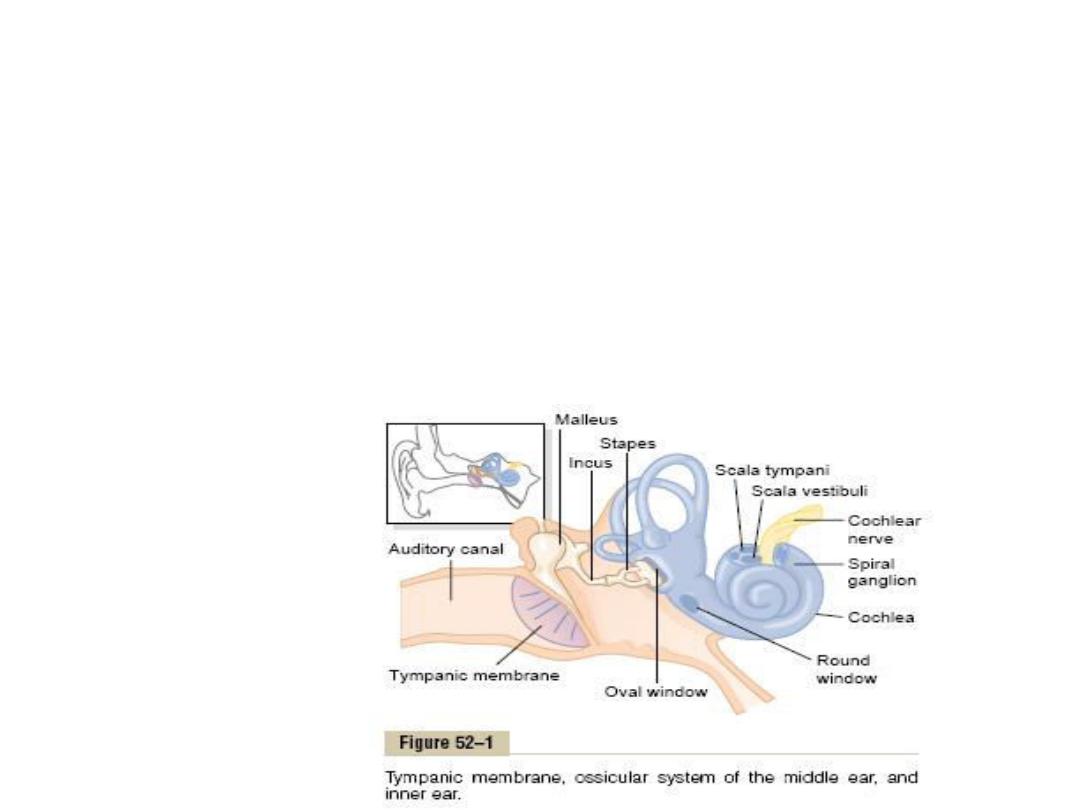
Auditary system:-
-The external ear, middle ear &the cochlea of
the inner ear are concerned with hearing.
-The semicircular canals, the utricle &the
saccule of the inner ear are concerned with
equilibrium.

Physiology of Hearing:-
The ear converts sound waves in the external
environment into action potentials in the
auditory nerves. Sound waves entering the
external auditary canal move the tympanic
membrane and this movement transmitted to
the ossicles (Malleus, incus, and stapes) of the
middle ear, which amplify and transform this
movement of ear drum into smaller and more
forceful movements of the footplate of the
stapes which rests against the oval window

Of the inner ear.
Movement of the stapes against the oval window will
produces travelling pressure waves in the perilymph of
the scala vestibuli and subsequently by
Reiss er’s
membrane (which separates the scala vestibuli from
the scala media) to the endolymph of the scala media,
then these waves transmit by the basilar membrane
(which separates the scala media from the scala
tympani) to the perilymph of the scala tympani and out
through the round window.
As the sound waves enter the perilymph of the scala
vestibuli it will transmitted to endolymph of the scala
media, this causes displacement of basilar membrane
which inturn stimulates the Hair cells in the organ of
corti. So movement of hair cells will generate
electronic potential that are converted into action
potentials in the auditory nerve fibers.
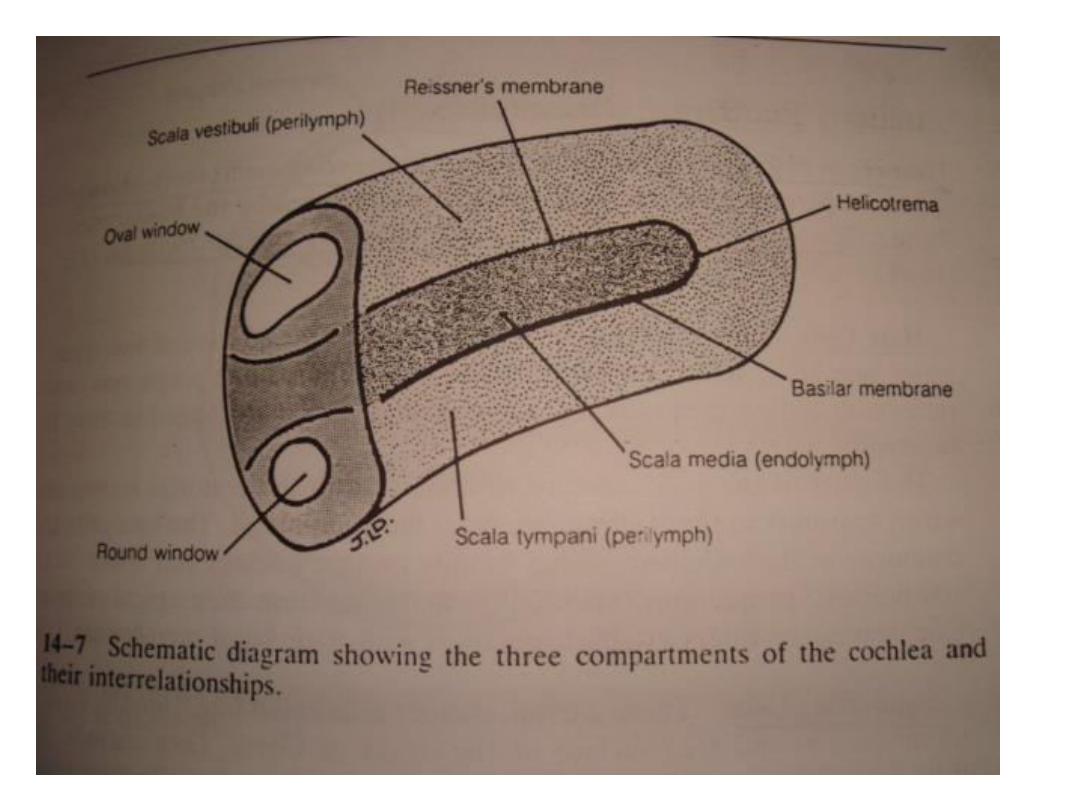
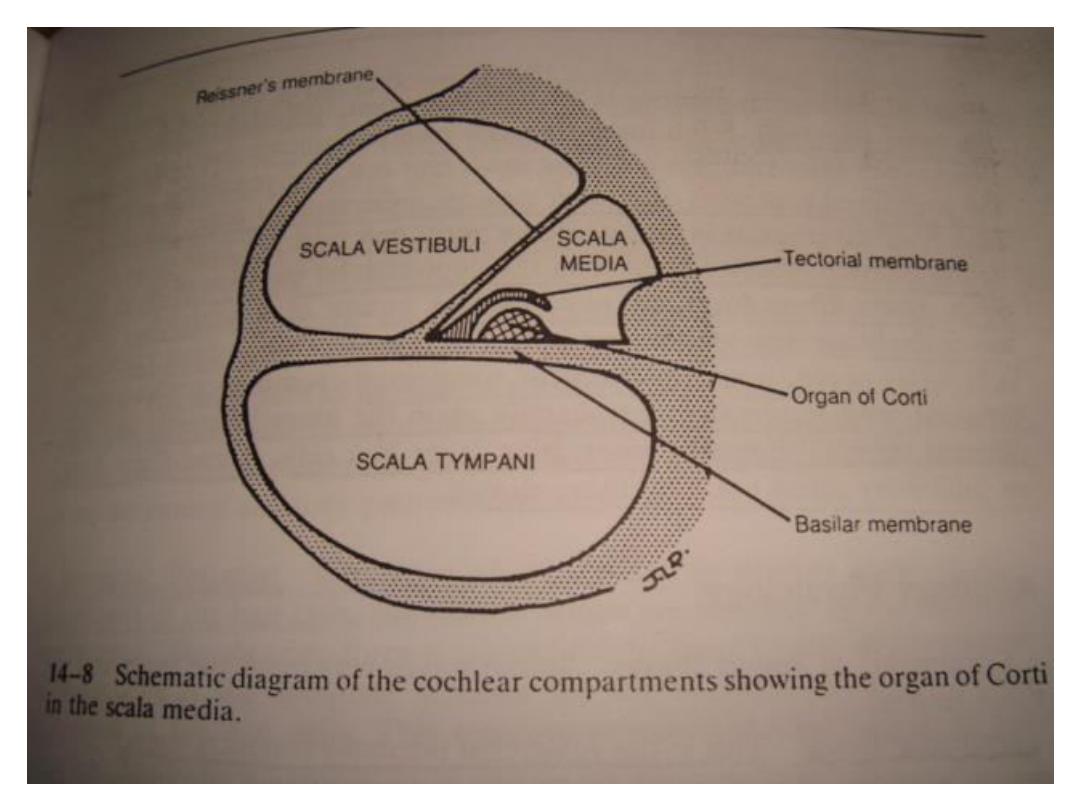

Central auditory pathway
The afferent fibers in the cochlear division of 8
th
cranial nerve ends in the dorsal and ventral
cochlear nuclei in the medulla, from there
auditory impulses pass by various routs to
inferior colliculi in the midbrain and then pass by
the medial geniculate body in the thalamus to the
auditory cortex located mainly in the superior
gyrus of temporal lobe (Broadmann's area 41).
In the primary auditory cortex most neurons
respond to input from both ears.
Adjacent to primary auditory cortex is auditory
association cortex which receive impulses from
primary auditory cortex.
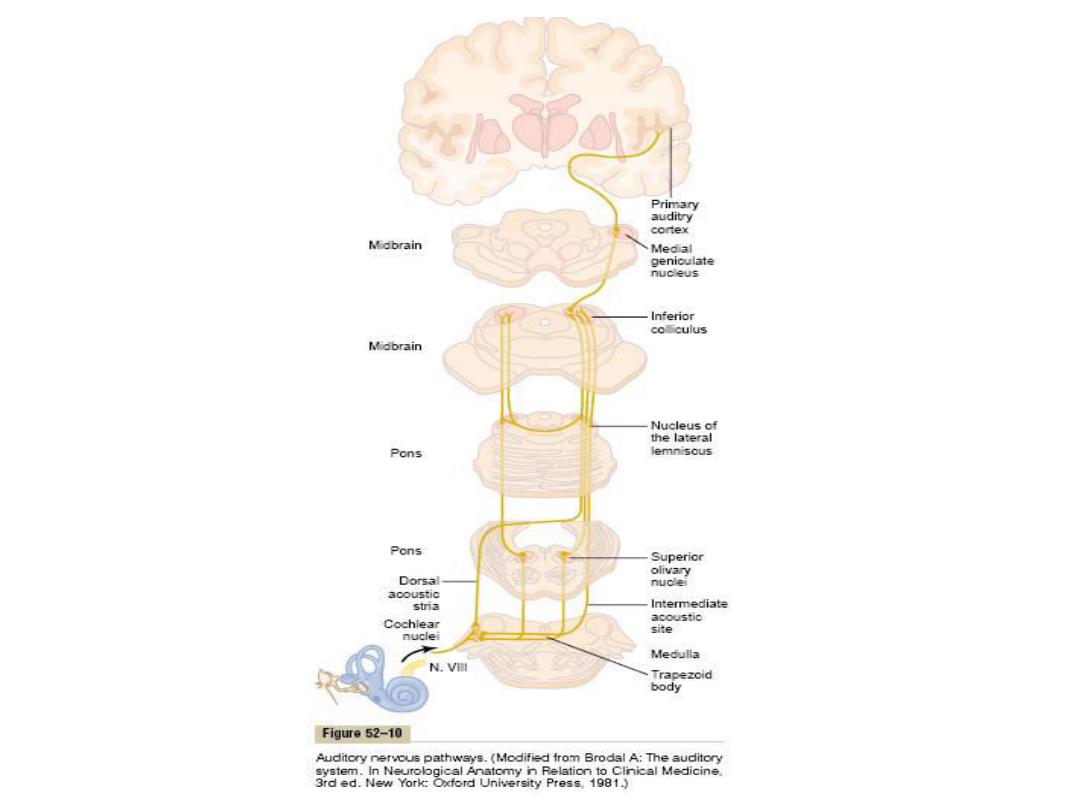

Deafness
Deafness is usually divided into two types:
Conductive deafness:
This type is caused by impaired sound transmission in
the external or middle ear.
Nerve deafness:
This is caused by damage to the cochlea or the
auditory nerve of the central neural pathway.
These two types of deafness can be differentiated by
a number of simple clinical tests using a tuning
fork.

Vestibular system:-
The vestibular structures provide the nervous
system with information about gravity, rotation
and acceleration that is necessary for
maintenance of balance and equilibrium.
The receptors of the vestibular sense organ are
located in the semicircular canals, utricle, and
saccule in the inner ear. The utricle and saccule
are located in the main cavity of the bony
labyrinth while the semicircular canals 3 in No.
are extensions from the utricle.
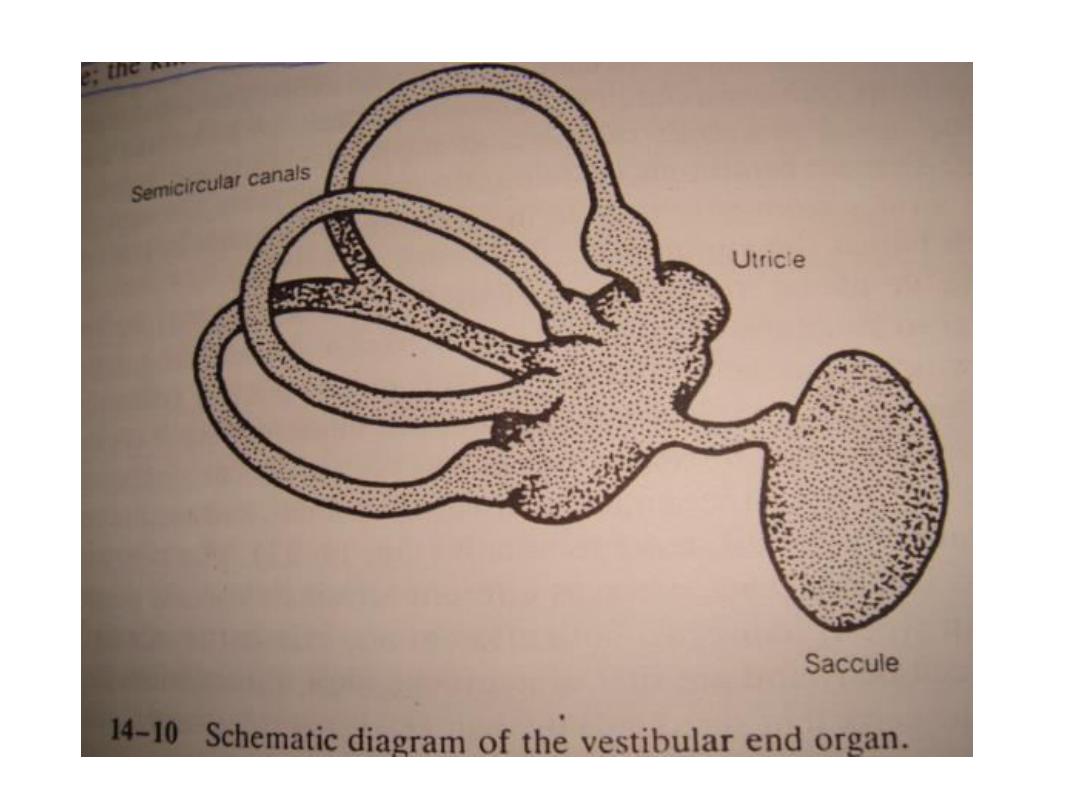

The utricle & saccule contain endolymph.
Specialized areas of epithelium called macula are
present in their walls. Each macula is a tuft of
ciliated columnar epithelial cells embdded in a
gelatinous matrix containing small calcified
particles (otoliths).
When the head is tilted from the vertical position,
gravitational pull on the otolith distorts the hair
cells and initiates an action potential in the
vestibular nerve. So Utricle & saccule are
responsible for linear acceleration of the body.

At one the end of each simicircular canal is an
enlargement called the ampulla which
contains a specialized region of epithelium
called crista which is similar to maculae in
saccule & utricle, during rotational movement,
the endolymph in the semicircular canal
moves and distorts the crista, thus stimulating
the hair cells and initiating action potentials.
So semicircular canal responsible for angular
acceleratrion of the body.
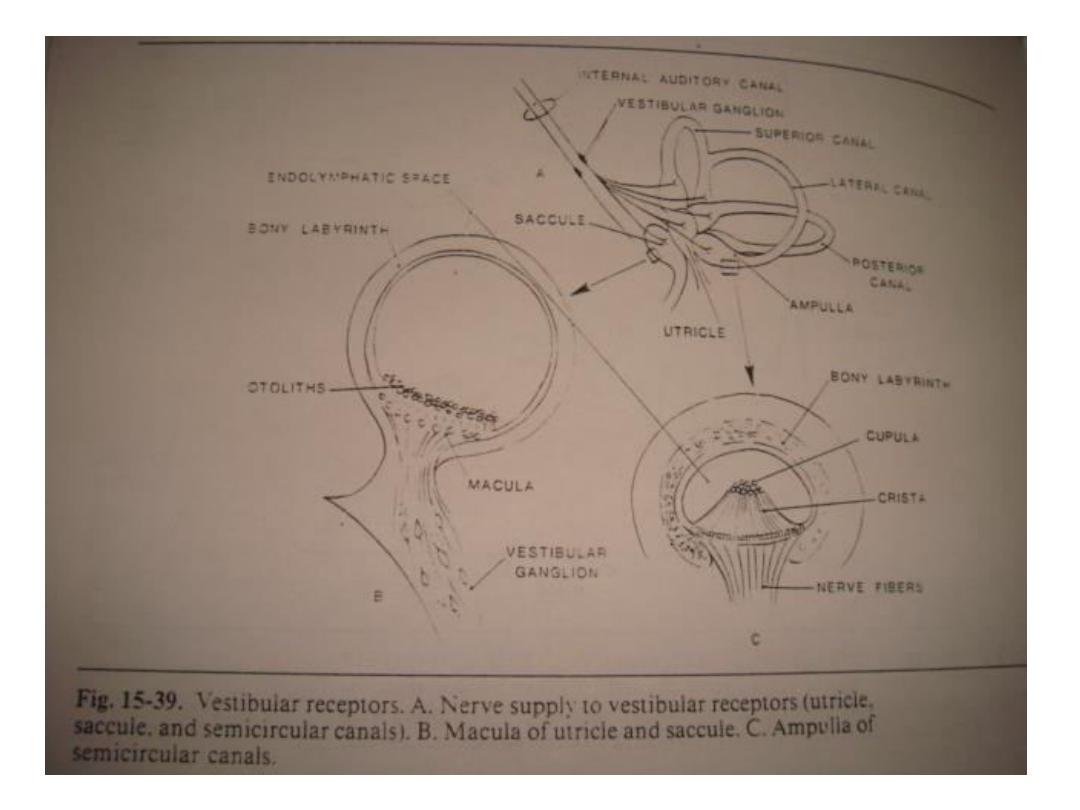

The adequate stimulus to discharge hair cells is
movement of the cupula which bends or
deforms the stereocilia as bending of stereocilia
toward the kinocilium increases the frequency
of resting discharge, where as bending the
stereocilia away from the kinocilium lowers the
frequency.
Under normal resting conditions the nerve fibers
from hair cells transmit continuous nerve
impulses.
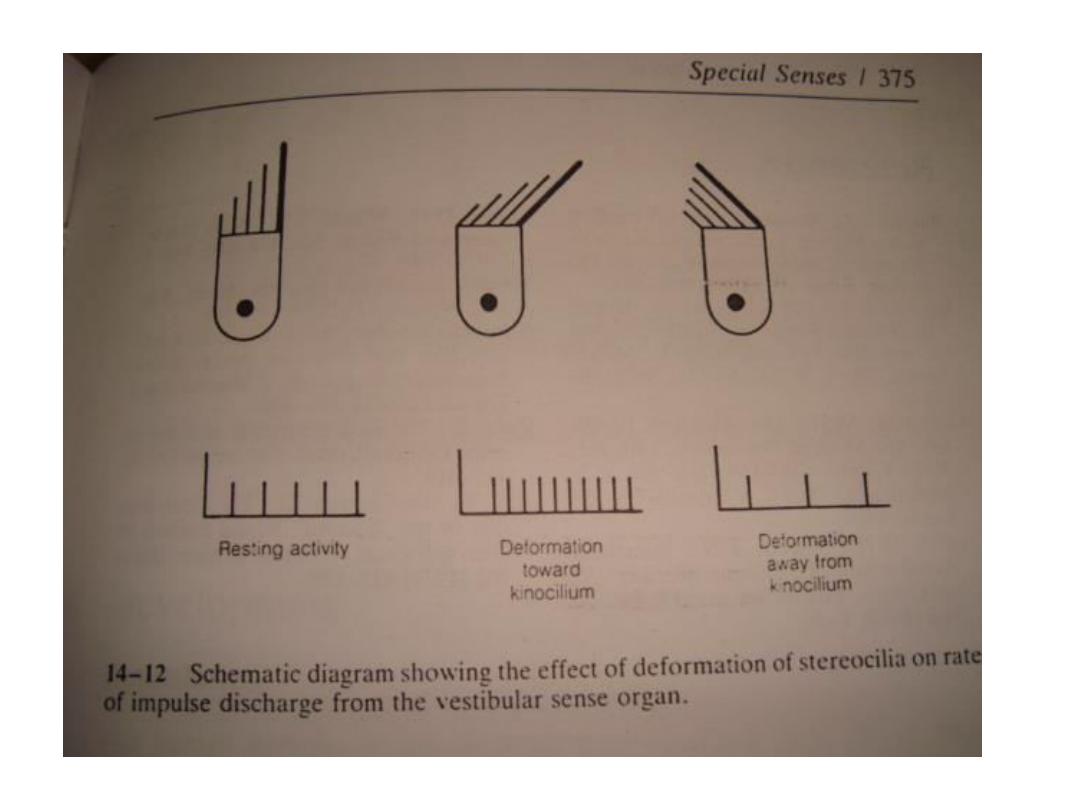

Neural pathways:
Stimulation of hair cells in vestibular apparatus activate
sensory neurons of 8
th
cranial nerve (vestibular
branch).
Fibers of vestibular nerve pass to the vestibular nuclei of
brain stem and also to the cerebellum, From the
vestibular nuclei neurons pass to occulomotor center
to control eye movement and also to the spinal cord to
stimulate movements of the head, neck and limbs.
Also nerve signals pass upward to the cerebral cortex
terminating in a primary cortical center for equilibrium
located in the parietal lobe, these signals appraise the
conscious awareness of the equilibrium status of the
body.

Vertigo:
Is the sensation of rotation of the body in
the absence of actual rotation.
It is caused either by lesions in vestibular
apparatus or a lesion in the central
neural pathway in brainstem or
cerebellum.

Taste
Taste receptors are located within taste buds in
the tongue (circumvallate and fungiform
papillae), as well as in the soft palate,
oropharynx and epiglottis.
Taste Buds:-
are barrel like structures composed from
receptor cells, supporting cells, basal cells and
nerve fibers.
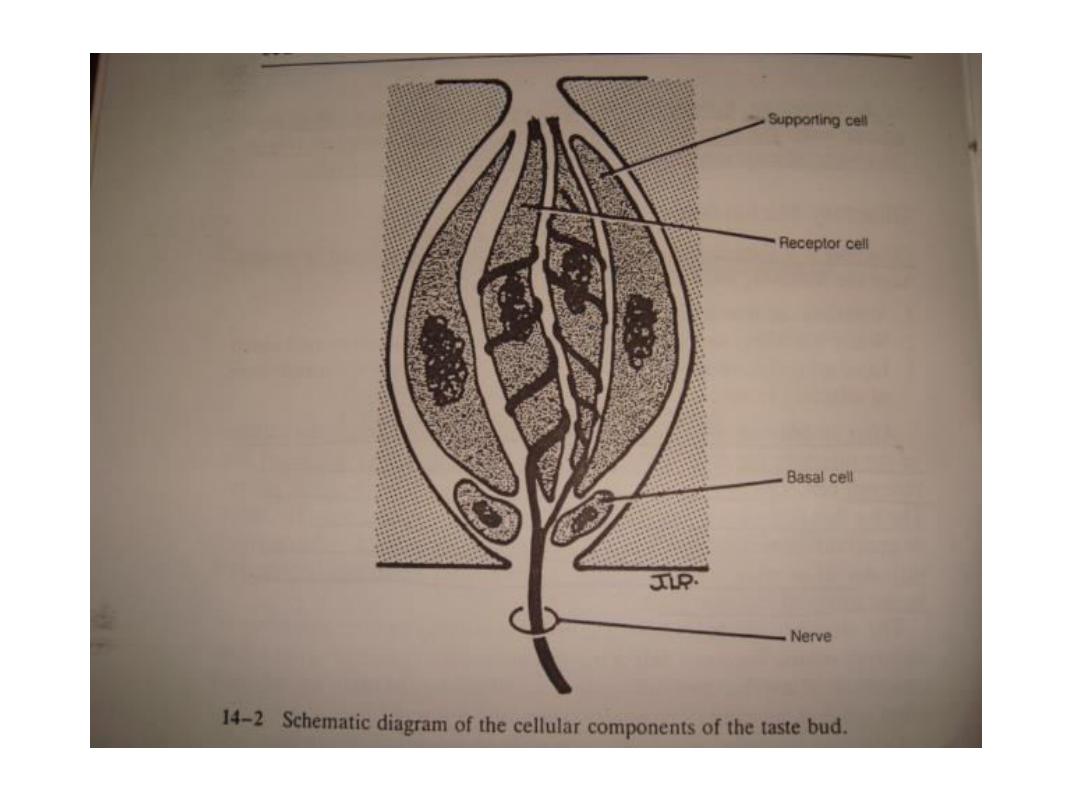

• Receptor cells:- (4-20) receptor cells located in
the center of each taste bud. Receptor
elements decrease in number with age and
the apex of each receptor cells is modified
into microvilli which increase the receptor
surface and project into an opening (Taste
pore).
• Supporting Cells:- Spindle – shaped cells which
surround the receptor cells and are located at
the periphery of the taste bud. its function is
to secret the substance that bathes the
microvilli in the taste pore.

• Basal Cells:- are located at the base of the
taste bud and by division it will replenish the
receptor cells that are continually lost.
• Nerve fibers:- These are terminal nerve fibers
of the facial, glossopharyngeal and vagus
nerve it wind themselves around the receptor
cells in close apposition with receptor cell
membranes.

Physiology of Taste
-humans have five primary tastes sweet, sour, bitter, salt and
umami.
- A person can perceive hundred of different tastes but they
are all are result of combinations of the of the primary
taste sensations.
Sour taste is caused by acid that is the (H) ion concentration.
Salty taste is elicited by ionized salts mainly by Na ion
concentration.
Sweet taste is not caused by any single class of chemicals.
Example of substance that cause this taste includes sugars
, glycoli ,alcohols, aldehydes , ketons , some amino acids .
most are organic chemicals. Bitter taste is also not caused
by any single type of chemicals agent.

two particular classes of substances cause bitter taste :
1. long chain organic substance that contain nitrogen.
2. Alkaloid; this include many drugs.
The bitter taste when occur in high intensity usually
cause the person to reject the food this important
function of the bitter taste because many deadly
toxics found in poisonous plants are alkaloids.
Umami
is a Japa ese word ea i g delicious
designating a pleasant taste sensation that is
qualitatively different from sour, salty, sweet or
bitter.
Umami is the dominate taste of food contain L-
glutamate such as meat extracts and aging cheese.

Mechanism of stimulation of taste Buds
The mechanism by which most stimulating
substances react with taste villi to initiate The
receptor potential is by binding of the taste
chemical to a protein receptor molecule that lies
on the outer surface of the taste receptor cell
near to or protruding through a villus membrane,
this in turn opens ion channels which allow
positively Charged ions to enter and depolarize
the normal negativity of the cell, then the taste
chemical it self is gradually washed away from
the taste villus by the saliva which removes the
stimulus.

On 1
st
application of the taste stimulus the rate
of discharge of neuron fibers rises to a peak in
a small fraction of a second but then adapts
within next few seconds back to lower, steady
Level as long as the stimulus removes.
Microelectrode studies from single taste buds
show that each taste bud usually respond
mostly to one of five primary taste stimuli
when the taste substance is in low
concentration but at high concentration most
buds can be excited by 2 or more of primary
taste stimuli.

Thank You
